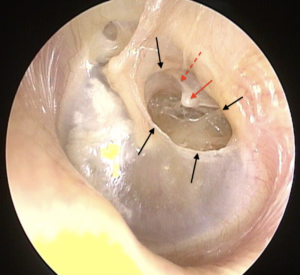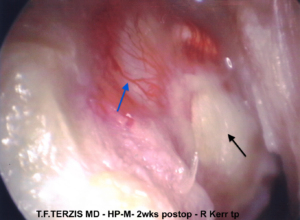Chronic Otitis

Chronic Inflammation of the ear can have various possible causes, the most important being inadequate treatment of acute ear infections, especially in patients who also have poor ventilation of the ear, due to dysfunction of the Eustachian tube. Chronic Otitis is typically combined with a tympanic membrane perforation (hole in the eardrum). Symptoms are hearing loss, tinnitus (buzzing or noises in the ear), and recurring purulent discharge.
In some cases of chronic otitis, skin cells are accumulated in a sac, which is formed inside the middle ear cavity. This sac, which is called cholesteatoma, expands inside the ear and can erode bone and threaten important structures, such as the facial nerve or the brain dura.
Exacerbations of chronic otitis are treated with local debridement by the doctor and application of ear drops, containing antibiotics and cortisone. However, permanent treatment of chronic otitis is surgical.

Tympanoplasty and Ossiculoplasty
The perforation of the ear drum is repaired by means of a thin membrane, which is called fascia, and is harvested by the surgeon from an appropriate area behind the ear. This membrane is placed under the perforation and with time is fused with the eardrum remnant. The operation is called tympanoplasty and is performed under general anaesthesia. Typically it lasts for about an hour and requires one night stay in hospital.
If there is also erosion of the little bone (ossicles) behind the perforated eardrum, the surgeon repairs the defect with special implants and/or cartilage from the pinna, and the operation is called ossiculoplasty.
After the completion of the healing period, usually in a month’s time, the ear is watertight, does not discharge anymore and the hearing improves.
Mastoidectomy
Often in Chronic Otitis, apart from the middle ear space, we need to access the mastoid cavity, behind the ear, to clear the inflammatory tissue, which produces the pus, or to remove the cholesteatoma. The cavity is usually left open for draining and inspection. The operation is called Mastoidectomy, is done under general anaesthesia and lasts for approximately two hours. As in tympanoplasty, the patient can be discharged home on the next day. Healing takes more time than other ear operations. The ear needs to be kept dry for life. Follow-up and cleaning by a specialist, once or twice a year, is also necessary.
This website aims at providing simplified scientific information and not medical advice on specific conditions or individual cases. In this respect, it cannot replace the consultation and documented opinion of a specialist physician.